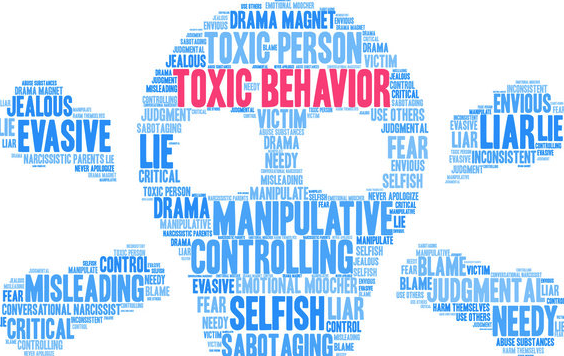In every workplace, there may be instances of toxic behavior that can negatively impact the overall work environment, employee morale, and productivity. Toxic behavior can manifest in various forms, such as bullying, harassment, gossip, or passive-aggressiveness. Recognizing and addressing these behaviors promptly is crucial to maintaining a healthy and thriving workplace. Today, we will explore effective strategies to identify toxic behavior and provide practical steps to address it, fostering a more positive and inclusive work environment.

Understanding Toxic Behavior
Before we can effectively address toxic behavior, it is essential to understand what it entails. Toxic behavior refers to actions or attitudes that are harmful, disrespectful, or disruptive to individuals or the work environment. Common toxic behaviors in the workplace include
- Bullying: Repeatedly singling out or intimidating colleagues, often through verbal or psychological means.
- Harassment: Engaging in unwelcome or offensive behavior based on characteristics such as gender, race, religion, or sexual orientation.
- Gossiping: Spreading rumors or engaging in negative conversations about colleagues behind their backs.
- Passive-aggressive behavior: Expressing hostility or resistance indirectly, often through subtle sarcasm, silent treatment, or sabotage.
Recognizing Toxic Behavior
Identifying toxic behavior can be challenging, as it often occurs subtly or indirectly. However, certain signs can help you recognize toxic behavior in the workplace:
- Frequent conflicts: Notice patterns of ongoing conflicts, hostility, or tension among team members.
- Excessive criticism: Consistently receiving unjustified or excessive criticism from a colleague or superior.
- Isolation and exclusion: Feeling left out, ignored, or isolated by specific individuals or groups.
- Manipulative behavior: Observing individuals who manipulate or exploit others to achieve personal gain.
- High employee turnover: Consistently losing employees due to a toxic work environment or negative behavior.
The Impact of Toxic Behavior
Toxic behavior can have severe consequences on individuals and the overall workplace environment. Some of the impacts include:
- Decreased productivity: Toxic behavior can create a hostile environment that hinders employee engagement and productivity.
- Increased stress and anxiety: Individuals exposed to toxic behavior may experience heightened stress or anxiety or even develop mental health issues.
- Lowered morale: Toxic behavior can significantly affect team morale, leading to decreased job satisfaction and motivation.
- Employee turnover: Persistent toxic behavior may drive valuable employees to seek opportunities elsewhere, resulting in high turnover rates.
- Damage to reputation: A workplace known for toxic behavior can develop a negative reputation, making it challenging to attract and retain talent.
Strategies for Addressing Toxic Behavior
Addressing toxic behavior requires a proactive and systematic approach. Here are some effective strategies to tackle toxic behavior in the workplace:
- Establish clear expectations: Develop a comprehensive code of conduct that outlines acceptable behavior and expectations for all employees.
- Encourage open communication: Foster an environment where employees feel comfortable reporting toxic behavior and discussing concerns without fear of retaliation.
- Provide training and education: Conduct regular training sessions to raise awareness about toxic behavior, its impact, and ways to prevent and address it.
- Lead by example: Leaders should set a positive example by demonstrating respectful behavior and promptly addressing any toxic incidents.
- Implement a reporting system: Establish a confidential and reliable reporting mechanism for employees to report toxic behavior, ensuring appropriate follow-up actions are taken.
- Conduct investigations: Promptly investigate reports of toxic behavior to gather facts, maintain transparency, and ensure a fair resolution.
- Implement consequences: Communicate the consequences of engaging in toxic behavior and enforce disciplinary actions when necessary.
- Support affected employees: Provide support and resources to individuals affected by toxic behavior, including access to counseling or mediation services.
- Foster a positive culture: Promote a culture of respect, inclusivity, and appreciation for diversity to counteract toxic behavior.
Building a Healthy Workplace Culture
Creating a healthy workplace culture is a long-term commitment that involves ongoing efforts from all stakeholders. Some key steps to foster a positive and inclusive work environment include:
- Regular feedback and recognition: Provide constructive feedback and recognize employees’ contributions to enhance motivation and job satisfaction.
- Encourage teamwork and collaboration: Promote teamwork, collaboration, and open communication among employees to build strong working relationships.
- Offer professional development opportunities: Invest in employees’ growth by providing training, mentoring, and opportunities for career advancement.
- Promote work-life balance: Encourage work-life balance by implementing policies that support flexible working hours, time off, and stress management initiatives.
- Celebrate diversity and inclusion: Embrace diversity and ensure that all employees feel valued and included, regardless of their backgrounds.
- Evaluate and refine policies: Continuously assess existing policies and procedures to ensure they align with fostering a healthy workplace culture.
Conclusion
Addressing toxic behavior in the workplace is essential for creating a positive and productive work environment. By understanding the signs of toxic behavior, recognizing its impact, and implementing effective strategies, organizations can foster a healthy workplace culture that benefits both employees and the organization as a whole. Embracing a culture of respect, open communication, and inclusivity is the key to creating a thriving workplace where everyone can reach their full potential.
Resources on Toxic Behavior in the Workplace
Here is a list of books from Amazon about Toxic Behavior in the Workplace.


